Episode #48: Giving Our Sons the Gift of Sound: A Mother’s Story of Cochlear Implants and ASL (Part 1)
Meet Felicia Aquilo, a mother of two boys who were born profoundly deaf. With loving guidance and unwavering support, Felicia and her husband embarked on an amazing journey to bring their boys the gift of sound through cochlear implants. What started out as an uphill battle is now a turning point - Felicia's sons are thriving in their new life with sound, learning to speak, and harnessing the power of both spoken and sign language. In this exclusive interview, Felicia shares her story, how the boys are adjusting to the new technology, and how music has become a source of joy for her family. This is part 1 of Felicia’s story. Don’t miss part 2 coming out next week! Can you guess which statements Felicia shared were her truths and which was her lie? Post your best guess on our Instagram account https://www.instagram.com/water.prairie/. We’ll post the correct answer on Instagram a week after the part 2 episode posts so be sure to check back later to see if you were right. 2 Truths and a Lie: 1. Felicia loves cooking and wanted to be on Master Chef 2. Felicia enjoys training and running marathons 3. Felicia’s known how to snow ski since she was 2-years-old Follow Felicia on Instagram: https://www.instagram.com/feliciaaquila/ Hands and Voices, a resource for families of deaf children: https://www.instagram.com/handsandvoices/ https://www.handsandvoices.org/
The Water Prairie Chronicles Podcast airs new episodes every Friday at Noon EST!
Find the full directory at waterprairie.com/listen.
How Cochlear Implants Opened up a New World of Communication
Show Notes:
Meet Felicia Aquilo, a mother of two boys who were born profoundly deaf. With loving guidance and unwavering support, Felicia and her husband embarked on an amazing journey to bring their boys the gift of sound through cochlear implants. What started out as an uphill battle is now a turning point – Felicia’s sons are thriving in their new life with sound, learning to speak, and harnessing the power of both spoken and sign language. In this exclusive interview, Felicia shares her story, how the boys are adjusting to the new technology, and how music has become a source of joy for her family.
This is part 1 of Felicia’s story. Don’t miss part 2 coming out next week!
Can you guess which statements Felicia shared were her truths and which was her lie? Post your best guess at https://instagram.com/water.prairie/. We’ll post the correct answer on Instagram a week after the part 2 episode posts so be sure to check back later to see if you were right.
2 Truths and a Lie
- Felicia loves cooking and wanted to be on Master Chef
- Felicia enjoys training and running marathons
- Felicia’s known how to snow ski since she was 2-years-old
- Follow Felicia on Instagram:
- Hands and Voices, a resource for families of deaf children:
- Instagram: @handsandvoices
- Website: www.handsandvoices.org
During our Season 2 episodes, we’ll be asking each guest to share “2 Truths and a Lie” about themselves as a fun way to get to know our guests. We’ve decided not to give the answer right away so our listeners can try to guess the true answers. In the comments section for this video, add your thoughts to which of Lenora’s answers were true and which was the lie. Here are the answers she gave us during the interview:
- She had a baking business.
- She hiked the Appalachian trail.
- She hiked the Tour du Mont Blanc.
*** We’ll post the answer on our Instagram account a week after this video posts so go there and check to see if you got it right!
- Instagram: @water.prairie
- Twitter: @waterprairie
Connect with Us: https://linktr.ee/waterprairie
Support this channel: https://www.buymeacoffee.com/waterprairie
Music Used: “LazyDay” by Audionautix is licensed under a Creative Commons Attribution 4.0 license. https://creativecommons.org/licenses/by/4.0/ Artist: http://audionautix.com/
Episode #48: Giving Our Sons the Gift of Sound: A Mother’s Story of Cochlear Implants and ASL (Part 1)
How Cochlear Implants Opened up a New World of Communication
(Recorded January 31, 2023)
Welcome to the Water Prairie Chronicles. A podcast created to encourage and support parents of special needs children. I’m Tonya Wollum, and I’m glad you’re with us today.
In today’s episode, you’ll meet Felicia Aquilo, a mother of two boys who were born deaf. After much research, Felicia and her husband embarked on an amazing journey to bring their boys the gift of sound through cochlear implants.
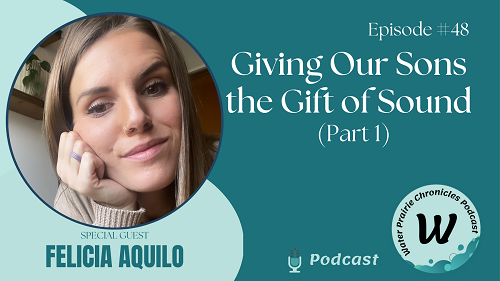
This is part one of my interview with Felicia, and I encourage you to make sure to listen to part two next week to hear the full story of how Felicia is actively involved in helping her sons communicate, how they’re adjusting to their cochlear implants, and how music has become a part of their lives.
Welcome back to the Water Prairie Chronicles. Everyone, we appreciate you being with us today, and I have a special guest with us. This is Felicia Aquilo. Felicia, I found on Instagram. I’m following her and enjoying what she shares about her family, and some of her experiences, and we’re gonna talk about some of that in the interview today. Felicia, I’d like for you to introduce yourself to us and then we can get into a little more detail about what I wanna talk about, but I don’t wanna release all the information upfront.
Thank you, Tonya. My name is Felicia Aquilo. I am the mom of two young boys who both happen to be deaf. They both have bilateral cochlear implants, so they have access to sound. It’s been a rollercoaster. So many crazy things happen in the past five years. My oldest is five, my youngest is almost two. So yeah, it’s just been a very exciting, unexpected experience.
So this is season two. We’ve started doing a different type of getting-to-know-you. So those that are listening, if you didn’t hear last week’s episode, we are now doing “Two Truths and a Lie” instead of our Speed Round of 10 questions. So I’ve asked Felicia to think of two things to share with us that are true and one that is not true.
She’s gonna mix them up so you don’t know which is which. And we’ll be posting this on Instagram and on Twitter so that you can post your guesses of what you think the answer might be. And if you’re watching this on YouTube, you can post it in the comments below as well. And in about a week, we will share with you what the answer is on Instagram so you can see if you are right or not.
So, Felicia, what are your two truths and a lie?

Well, number one, I love cooking and at one point in my life I wished I could be on Master Chef or own a restaurant. . Uh, number two is I really enjoy, um, training and preparing for running marathons like five Ks. And number three is I’ve known how to snow ski since I was two years old.
So let’s go back to the beginning. The beginning of when you first had your oldest child, Silas. When did you find out that he was deaf?
So I found out that Silas was deaf. Rewind a little bit. Um, when he was born, it was a perfect pregnancy, completely typical, nothing out of the ordinary. I thought I was, was prepared for anything and everything that could possibly happen.
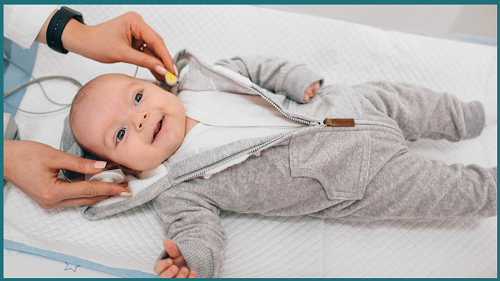
(This image was created on Canva.com.)
And he was born, I had this perfect new baby and within 24 hours we have the newborn hearing screening. So they took him back for that. I wasn’t expecting anything and, they said that he had failed it, which I hate that, that terminology because there’s no pass or fail for a hearing screening. It’s just what happened, you know?
Um, They told me that he had failed the hearing screening, but not to worry because it was probably just fluid, the amniotic fluid, and it’ll go away. So at that point, I really didn’t, uh, fully process. I had just had a baby. I was trying to wrap my head around everything and they, the next day they took him back again for the same test, and he, the same thing happened.
It was the same results that he had the first time. So that’s when they were like, we’re going to refer you to an audiologist and see what happens.
So that was just, just immediately then with that. And what was the diagnosis that they found out?
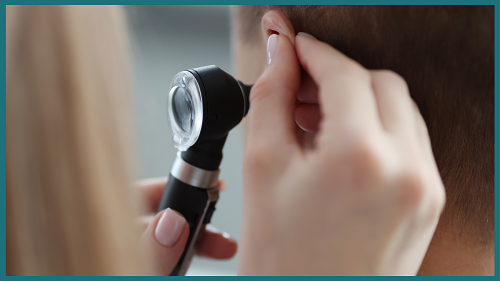
(This image was created on Canva.com.)
So two months later we went to the audiologist appointment.
He had what’s called an A B R. It’s an audio brainstem response test. And at that point, they told me that he was profoundly deaf. There was no response to any of the frequencies that they had tested. Um, and it was sensorineural meaning that it was not going to improve at all.
Okay. That’s tough cause you’re not ready for that when you’re first coming in. Did the doctor give you any contacts in your community or anything to help you kind of know what to do next?
So after, when he was a newborn, right after, uh, we got home from the hospital when he was born, there was really nothing except for the reference for the audiologist, I guess is the right word.
There was nothing other than that. So after we went to the audiologist, when she said, I’m sorry, your son is deaf, it was basically follow up with, um, another audiologist. We’re gonna start the process for hearing aids. This is what’s going to happen. . So I was like, okay, well wait a second. Let’s take a step back.
You just told me my son is deaf and now I have to leave and I am completely unprepared for what comes next.
Right, right. So, so at that young, do they do hearing aids right away?

(This image was created on Canva.com.)
They will. So they’ll, uh, early intervention will start. Basically, as soon as they get the hearing test done and all the testing, like the prerequisites for the hearing aids. Silas was, he finally got his hearing aids at about seven months.
And that’s because I took forever to really process the information and come to terms with it. In the beginning, I didn’t wanna believe it, so I got opinion after opinion. Um, trying to find different types of, you know, the solution. I, I didn’t know anything about being deaf or deafness or childhood deafness or deaf culture or the deaf community, so it was trying to figure out a way to make this not my reality when in turn that wasn’t what I needed to be doing at all.
Was he able to keep them on or did he pull them off all the time?
Oh, they were always off and they made the most awful noise and the feedback noise of the screeching sound in your ears. Um, it was terrible and not one of my most favorite parts of the process because they did not give him… Isaiah and Silas. Their hearing loss is two separate. Um, they, it’s the same type of hearing loss, but two different degrees. So Silas’s hearing loss did not give the hearing aids did not give him any access to sound whatsoever because of his profound deafness. So it was just kind of a, in order to go the CI route, if we were going to choose that you have to do a trial period of hearing aids to make sure that they aren’t working.
Okay, so he’s seven months old. When he got the hearing aids, did you know that that’s what you were doing at that point? Just doing the trial.
We knew we were gonna give him hearing aids. We did not know for sure that cochlear implant surgery was something that we wanted to do right away.
Um, originally we had thought that we were going to wait until he was able to tell us that he wanted cochlear implants. It took a lot of talking to people in the deaf community. I, I sought out so many people in the social media. Space that were going through something similar. Um, some people that we went to an ASL class and I wanted to meet a couple deaf people that could possibly give me some answers.
I looked for people that were using cochlear implants, people that had kids that were using cochlear implants, and even people that did not agree with cochlear implants because I wanted to know everything I possibly could. Um, because these doctors are coming at me saying, this is what you’re gonna do next.
This is the process. This is how we’re gonna go at it. And I’m just like, can we, this is a, a huge thing. I’m, my kid is he’s a baby and you’re talking about putting something in his head. I need to know everything. .
Right. Right. I have never talked to anyone who had a child who had used cochlear implants.
I remember. Rush Limbaugh when he first was losing his hearing and that was my first connection with anyone. And so I didn’t know if it was even children or only adults. Um, cuz it’s, it’s just, it’s not the world that I’ve been in, so I haven’t had that access. But, um, but I’m just thinking through, you know, as, as, I mean even a seven-month-old.
You’re still digesting things, you’re still learning how to get feeding schedules together, you know that that’s, that’s hard enough between sleeping and feeding at that, at that point for your first child and then to have to do all of this. Did you get some good feedback from these contacts between the ASL classes and the deaf community?
Were you able to find some people to help you?
I did. I found a lot of good information, a lot of scary information, um, a lot of just differing opinions. People from all different walks of life, kind of giving me their insight, what they believe. Um, he didn’t actually get implanted until almost 18 months because it took me that long.
I always say that I missed out on the first about six months of size life because I was so worried and overtaken. This diagnosis and that I didn’t know anything about that. It really, um, just caused me to miss out on a lot of, like all the baby firsts of my first baby, if that makes sense.
Yeah. Yeah. I can understand that. However, looking at him today, he’s not missing anything because of that. He was getting what he needed. But I know what you mean though, cuz you wanna have those memories. You wanna have that focus to be different from what it had to be. And we were the same way with our daughter. We were asking people. We were calling everyone we could think of just because we didn’t know where to go.
We didn’t know what to do, and we didn’t wanna make the wrong choice. So, you know, trying to even figure this out and knowing that as a young child, everything that you do now feeds into the future. And you know, if you make the wrong choice, you know, not that there’s always a right or wrong choice, it’s just your choice is what’s the right choice.
But you don’t know that one. If you’re going through it, you’re trying to figure out, you know, what is the right one for me even cuz I don’t have enough information to know those choices. So Silas was a little bit older whenever Isaiah was born. Um, did you know right away with Isaiah, did you pick up on it or was it the same hearing?
So it was. He had the same hearing test. We had already had the audiologist appointment scheduled because we knew that there was a possibility, a 25% chance of him having some degree of hearing loss as well. So we wanted to be on top of it, ready to go. Um, he did have the hearing test in the hospital, and he only failed.
I’m using quotes here, fail, failed the hearing on the right side. So the left side was better than the right side. Oh, and yeah, so we weren’t really under, we didn’t really understand what was going on there. We thought maybe it was a fluke and it was fine because they did bring up the whole fluid thing.
Again, not knowing that deafness runs right in our family or with, you know, our babies. So we kind of just went with it. We knew that when we left the hospital, we were already going to go to the audiologist. And when we got to the audiologist about a month and a half later, um, it was Silas’s audiologist.
So we already had a relationship with her and it was a lot good. Better of an experience being the first time she said that his hearing test looks a lot like Si’s, but it’s severe, sloping profound. So a few of the. deafness is a spectrum. So a few of the frequencies that she tested were coming back, that he was hearing just a little bit and it was different than what Silas’s was.
Okay. Okay. So did you, um, did you already know that if he, if he were going to be determined as deaf when he was born, that you would do the cochlear implants with him as well?
Absolutely. By this time, Silas was three and a half, three, almost three and a half, and we had seen such wonderful results and we knew, I knew wholeheartedly that I made the right decision at this point because of the way Silas loves his relationship with sound.
He loves to hear music. He knows that he doesn’t have to wear his processors whenever he doesn’t want. , but I would say that a good 90% of the time he has them on and it’s always because it’s his choice. So, seeing all those first, like him, you know, the first time he was verbally able to say, I love you, or hear me say I love him, and ask for music and sing along to music.
Just all of those first times and all those magical moments made everything else just so worth it.
I’ve seen some posts you’ve had on just in the last few months, um, of the boys with, with music going, and I’m thinking the chaos in your house sometimes, because the volume probably is not controlled as much.
No, they’re, that’s the one thing about deaf children is they are not quiet at all.
Yep. with the cochlear implants. So humor me here because I’m totally ignorant on this. . I see. Um, in pictures that you have of Isaiah, he’s wearing a headband. Mm-hmm. . So the implant is attached to, is it to the bone in the, like, is attached to the skull.
How is it, how is the actual implant being used?
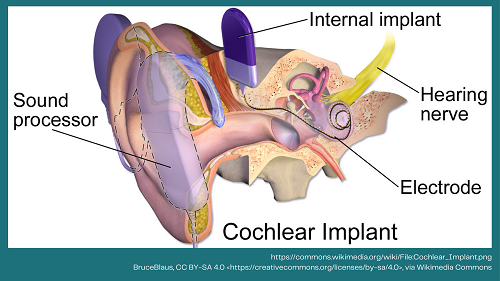
BruceBlaus, CC BY-SA 4.0 <https://creativecommons.org/licenses/by-sa/4.0>, via Wikimedia Commons
So there is an internal piece that sits underneath the skin, behind the ear. Um, they actually implant it behind the ear and the electrodes go down to the cochlea. . Um, the, that’s what sends the sound signals to the cochlea to be processed in the brain as sound.
It’s magnetic. Okay. So the external piece sits on top of the internal piece, um, and it kind of just magnetizes and it, it sits there, um, right on top of it. So that’s how it stays on there.
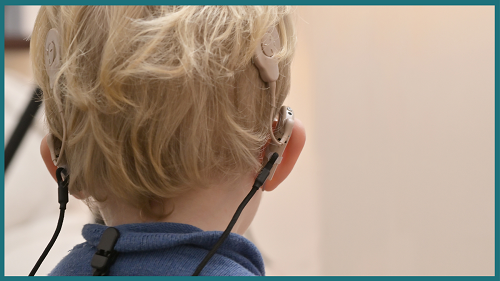
(This image was created on Canva.com.)
So, so when he’s wearing the headband, is that holding it?
Yeah, that’s just a retention method because if he rips ’em off or takes ’em off or they fall off, it helps me to find them or just helps to keep ’em on, especially when he’s that little.
Right. Well that’s what I was thinking cuz I noticed pictures that you’re showing of Silas, he’s not wearing the headband.
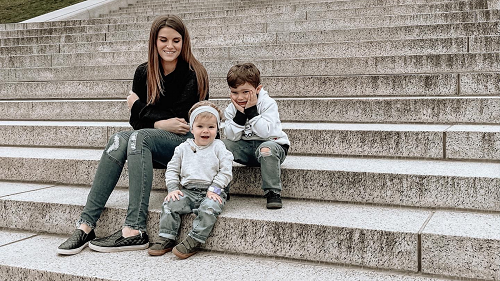
(Photo provided by Felicia Aquilo for use in this blog post)
No. He, right now he has a sports necklace retention line, which basically is just a black, uh, cord necklace he wears and there’s two little hooks that hold the batteries in there so that way if they do fall off, they’re not gonna just, they’re both very active
So I needed something to keep them in their spots because it’s also very hectic having a lot of money run around on your children’s heads. I’ve tried nearly every single retention method you could possibly figure out to keep them on their heads.
Do you have, and I haven’t looked through your Instagram enough to see, do you have like, um, shopping links or anything on there?
So if anyone’s looking for that type of thing where they can see where you’ve gotten what you’re using.
Yeah, I have an Amazon storefront that has a cochlear implant accessory, um, kind of list. On one spot. And I’m really good too, about, um, if somebody messaged me wanting a link, a lot of them are from Etsy or the Cochlear store, um, itself.
I’m good about sending those over too. So,
Oh, good, good. Yeah, so those that are listening, um, in the notes for this episode, we’ll put her Instagram, but, um, but, you know, check, check it out. I, I would encourage you to see what she’s doing. She’s really posting a lot of really good content. If nothing else, that resource alone will be enough to know where things that you’ve already tried and tested, um, to know where, where to start if you’re, if you’re looking for something like this.
We talked about wearing the implant and kind of how that, how that works with the magnetic part. what was the process of adjusting to them and learning how to use them both for your kids and for you too? Cuz at this point, you were learning. Not them as much.
Yeah, so I would say in the beginning, um, with Silas and Isaiah, but although with Isaiah I had already done it once, so I knew what to expect, um, the process. , keeping them on their heads, um, trying to figure out what the difference between them needing a listening break and it becoming a game. Because eventually, if they know that you’re reacting to them, pulling them off of their heads, they’re gonna keep doing it just to get your reaction.
And then on the other side of that, the listening fatigue that comes along with constantly processing, um, is a lot. It’s overstimulating, especially for a baby, basically, um, to have to learn how to do that. So, Juggling that, trying to figure out, you know, what’s just the wanting a reaction, what’s actually listening fatigue, and then the care that goes along with it as far as like putting ’em in the dry kits at night, making sure their implant site isn’t getting infected and rubbing the, you know, vitamin E oil on it.
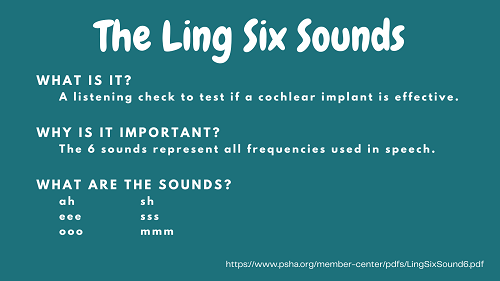
https://www.psha.org/member-center/pdfs/LingSixSound6.pdf)
Making sure that they’re hearing you. So doing the, the proper ling six sounds every day, um, where it’s like, I don’t know if you want me to go through and do them, but, uh, there are six sounds that you practice with your kids every day to make sure they have access to all of the speech sounds. Um, oh, just kind of.
all of the things that come along with it. And then charging them, you know, replacing batteries, making sure you have batteries in stock, you’re not going to run out. Uh, making sure that every night they go on the charge or just that kind of thing. Um, it was a lot to get used to. And then when Isaiah was born and he had his implantation surgery, it doubled
Right, right. So where the outer piece is attaching to the internal part, where the magnet is, did you have any trouble with hair loss in those areas?
Yeah, so the magnetic spot, um, where the magnet sits on their head, Silas has actually had a little bit of hair loss there.
More so from, we used to use clips. Hair clips. and, um, he would rub his head and try to like, uh, he wasn’t trying, but they would pull his hair so he would have big bald spots where the clips were. Right. The magnets not so much themselves, but I do notice that it’s easier to keep the magnets attached when that part of his head is shaved.
Just a little bit shorter than everything else.
You’ve mentioned a few little things there. Are there any other concerns or risks that are associated with the implants that, that you’ve had to think?
Well, like any technology, you have the risk of it failing or something going wrong with the internal piece.
Um, technology’s not forever, and that’s why I don’t necessarily a hundred percent rely on their technology for them to communicate. That’s why we use ASL, lipreading, a total communication approach. Um, but there are, so say the boys were to get a hearing or an ear infection, there is risk there if the ear infection is not cleared up right away.
It could possibly go to the implant site causing, you know, a worse infection or meningitis. They do have a higher risk of meningitis because of where the implant sits at. Okay. Um, there is the risk of needing an explant because of infection. So say down the road, Silas gets hit in the head with a baseball, God forbid, and there is actually a cut there, um, that can cause an infection and they would have to actually take the implant out and re-implant somewhere else in a different location. Um, so there, there are obviously risks as with anything, um, very rarely, knock on wood, do they happen, but they, I have heard of cases where, you know, I don’t wanna speak for every cochlear implant mom or user because there are situations that bad things can.
Right. Will there be, um, like will they, will they need to have any type of at restrictions in sports and things or will they be able to participate as much as they want.
They will be able to participate as much as they want. Um, I believe the only thing that they aren’t able to do is dive a certain amount of feet under water. Like nothing, like in a pool would even be, but like way like deep sea diving. I’m not sure the, the exact, um, number there. But as far as sports, you know, I would prefer they not play football . Um, I would definitely prefer that I’m going to be putting Silas in some tee-ball and some, uh, golf lessons and some drum lessons, but I, I’m going to let them do whatever they want to do. Cause I’ve always told them, you know, you’re capable of doing whatever you want to do, but we’ll see.
Join us next week for the rest of Felicia’s story of how cochlear implants have opened options for her children and some of the decisions her family will need to make in the next few years about education and advocacy.
You don’t want to miss the valuable information she shares for parents facing a similar diagnosis, as well as tips for anyone communicating with someone who is deaf.
This podcast is made possible by support from our listeners. If you wanna help offset the cost of producing the Water Prairie Chronicles, become a supporter at https://buymeacoffee.com/waterprairie.
You’ve been listening to the Water Prairie Chronicles, a podcast created to encourage and support parents of special needs children. I’m glad you were able to join us today, and I hope to see you back next week for another episode of the Water Prairie Chronicles.
Meet Today’s Guest:
 Felicia Aquilo is the proud mother of Silas and Isaiah, 2 boys who were born profoundly deaf and have received bilateral cochlear implants. Felicia and her husband, Steve, are raising the boys by teaching them to speak and to use sign language. They are hearing parents, but they are doing an awesome job of learning the skills they need to make communication easy for their sons! Felicia is active on Instagram and can be found @feliciaaquilo.
Felicia Aquilo is the proud mother of Silas and Isaiah, 2 boys who were born profoundly deaf and have received bilateral cochlear implants. Felicia and her husband, Steve, are raising the boys by teaching them to speak and to use sign language. They are hearing parents, but they are doing an awesome job of learning the skills they need to make communication easy for their sons! Felicia is active on Instagram and can be found @feliciaaquilo.
